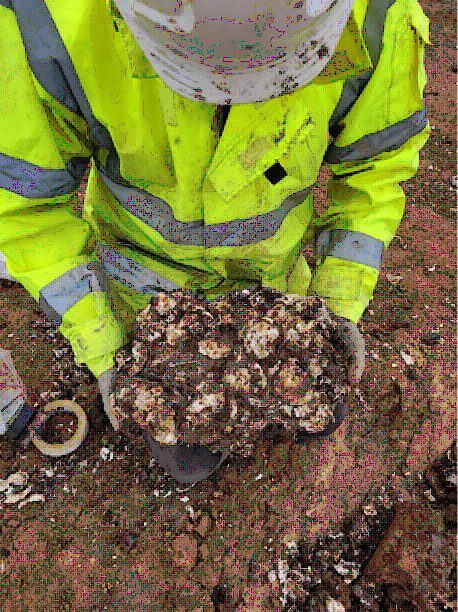
A Roman oyster processing site has been uncovered during the building of a major coastal re-alignment scheme in the North-East of England. The scheme will alter the location of existing flood defences so that new habitats can be created for wildlife, explains the Environment Agency (EA). The new habitats will also increase levels of flood protection to local communities by absorbing wave energy.
For the last three years the EA has been re-aligning the sea defences to provide 250 hectares of new wet grassland, saltmarshes and mudflats to replace land being lost to human activity on the north bank of the Humber Estuary. Before starting the work, they funded a series of archaeological excavations to reveal the fascinating history of this corner of Yorkshire.
A team from York Archaeology have discovered what is believed to be a Roman oyster processing centre close to what they think was an early Roman settlement.
Oysters were highly prized by the Romans with some reports suggesting they played a key part in Julius Caesar’s decision to invade the British Isles. Many of the oysters were exported to Italy with Roman Emperors reportedly paying for them by their weight in gold.
The Roman oyster processing site found in the Humber estuary is just south of Weeton, near Hull, where large quantities of misshapen oyster shells were found supporting the theory that they grew naturally on a shell reef rather than being grown on ropes which was a recognised practice at the time.
Today, oysters, which are natural filters, keeping the water clean as they absorb carbon and release oxygen, are being re-introduced to the Humber once again as part of the Wilder Humber partnership, comprised of Yorkshire Wildlife Trust, Lincolnshire Wildlife Trust and Orsted. The oyster reefs will help protect the coastline from erosion by stabilising the seabed and absorbing wave energy.
Jennifer Morrison, Senior Archaeologist for the Environment Agency, said: “It was truly amazing to find the evidence of this early oyster processing site during our dig. We know that, at this time, oysters would have been plentiful and that they were a staple part of the diet. We also know that British oysters were prized by the Romans, and it is quite possible that some these oysters found their way back to Italy.”
She added that the public can learn more about the oysters and about the Roman and medieval finds by visiting a new exhibition which is running all this month and until 22nd June at Hedon Museum in Hedon, near Hull.

Holderness Histories – ‘A Flight Through Time’ will showcase, not just archaeological artefacts, but will provide an insight into the current work by the Environment Agency to re-align the sea defences and provide vital compensatory wildlife habitats on the Humber estuary.
- The exhibition, run by the Environment Agency and York Archaeology, is at Hedon Museum, St. Augustines Court, Hedon, Hull HU12 8EP on Wednesdays and Saturdays
- To find out more about the re-introduction of oysters in the Humber estuary go to: Restoring native oysters in the Humber estuary | Yorkshire Wildlife Trust (ywt.org.uk)
Background on the Skeffling to Oustrays Managed Re-alignment Project:
- The ‘Outstrays to Skeffling Managed Realignment Scheme’ is a joint initiative by the Environment Agency and Associated British Ports and it is being built by JBA Bentley. Outstrays to Skeffling Managed Realignment Scheme – Environment Agency – Citizen Space (environment-agency.gov.uk)
- A new embankment is being built further inland to establish a new line of flood defences and then the old embankment will be breached, so that sea water can enter through the breach to create intertidal habitat.
- Approximately 175 hectares of new mudflat and saltmarsh habitats will be created on the north bank of the Humber estuary, near Skeffling, along with 75 hectares of wet grassland habitat in the area north of Winestead Drain.
- ‘Managed realignment’ means altering the location of existing flood defences so that new habitats can be created for wildlife that can also increase levels of flood protection by absorbing wave energy.
- The scheme, which started on site in 2021, is now in its final year of construction.







